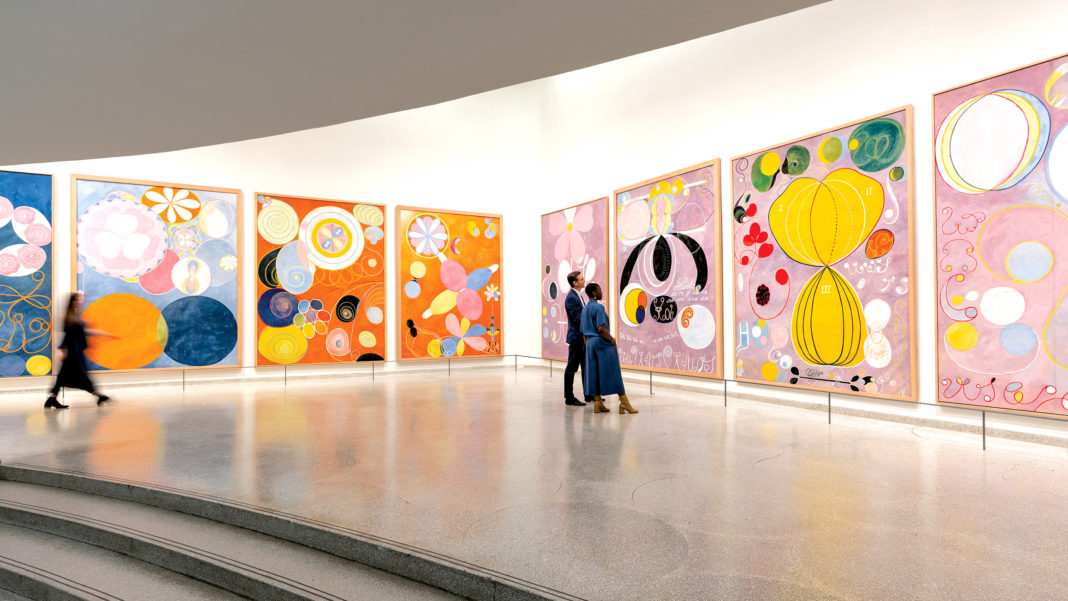Author: Kate Kellaway
Was Hilma af Klint Europe’s first abstract artist – before even Kandinsky and Mondrian? As an exhibition of her extraordinary, occult-inspired works opens at the Serpentine Gallery, London, we travel to Sweden to find out
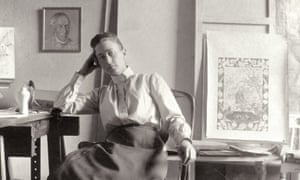
It is a cold afternoon in February and I am about to catch a plane to Stockholm in pursuit of a Swedish artist whom most people have never heard of: Hilma af Klint (1862-1944). I am hoping to find out more about an extraordinary story – a secret life that was not destined to stay secret. I consider a photograph of her – a daguerreotype, taken in 1885, at the Royal Academy of Arts, Stockholm, from which she graduated in 1887 as a traditional landscape, portrait and botanical painter. The scene is formally set up. She holds a palette in her left hand, an open parasol is behind her. Her face is inward, patient, unexceptional. There is nothing to suggest that this woman, on the quiet, was about to produce breathtaking abstract art as if she was painting in the 21st century – and, in 1906, before Kandinsky, Malevich or Mondrian.
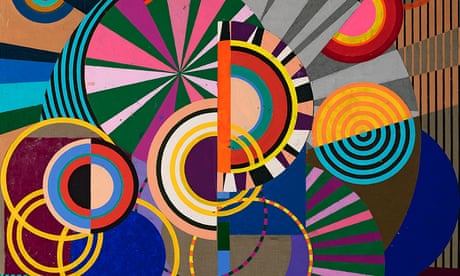
Sign up to the Art Weekly email
Read more
A second photograph, although unpeopled, will tell more. It is of a room furnished with a cluster of chairs including a decorative rocking chair. A plume of feathers fans out above a small table. And it was in this room that, every week for 10 years (1896-1906), Af Klint conducted seances with four other female artists, “the Five” (de Fem). She was the group’s founder and medium (their experiments with automatic writing and drawing predated the surrealists by decades). It was here, in 1904, that Af Klint received a “commission” from an entity named Amaliel who told her to paint on “an astral plane” and represent the “immortal aspects of man”. Between 1906-1915, there followed 193 paintings – an astonishing outpouring – known as the Paintings for the Temple. Whatever one’s misgivings about the occult, she worked as if possessed – in the grip of what can only be described as inspiration. She explained that the pictures were painted “through” her with “force” – a divine dictation: “I had no idea what they were supposed to depict… I worked swiftly and surely, without changing a single brush stroke.”
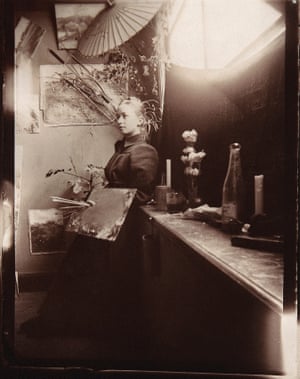
It is as if Af Klint has appeared out of nowhere – inconveniently for art historians. And the question she raises will not recede: was she a quirky outsider, or was she Europe’s first abstract painter, central to the history of abstract art?
She stipulated in her will that her work should not be shown until 20 years after her death
And why are we only hearing about her now? Hilma af Klint must partly answer – or answer for – this herself. When she died, aged 81, in 1944, she stipulated in her will that her work – 1,200 paintings, 100 texts and 26,000 pages of notes – should not be shown until 20 years after her death. It was not until the 1986 Los Angeles show The Spiritual in Art that her work was seen in public, and although other shows have followed, it is through Stockholm’s sensational 2013 exhibition, Pioneer of Abstraction, that she has blazed into view internationally – it was the most popular exhibition the Moderna Museet has ever held. And now, thanks to this show, she is coming to London’s Serpentine Gallery in an exhibition entitled Painting the Unseen (3 March – 22 May). A thrilling selection from the Paintings for the Temple will include the most staggering of all her works: a group of works called the Ten Largest (eight of which will be shown). These pictures, oils and tempera on paper, are more than 10 feet tall: free-wheeling, psychedelic, animated with fat snail shells, perky inverted commas, unspooling threads, against orange, rose and dusky blue. Man’s evolution is their sober subject, but their gaiety recalls Matisse (Af Klint predates him too).Advertisement
If I had to sum up the work, I’d borrow William Blake’s words: “Energy is eternal delight.” This is painting to gladden the eye (even before you have mugged up on the symbolism). And the Serpentine’s vote of confidence in it could not be clearer: she is the earliest painter to be shown in a one-person exhibition at the gallery.
On Thursday morning, walking to the Moderna Museet, I am struck by the uncanny silence in Stockholm, the wide pavements for crowds that never materialise, the sense that everything is clean and cold, candles glimpsed through every window, great white boats parked on the water. There is a feeling that everything about this handsome city is a pledge against the dark, a wait for the light. The water has splintered ice in it, clinking as if in a cocktail glass. And it was here that Hilma was born on 26 October 1862. I am about to meet her great-nephew, Johan af Klint, and Iris Müller-Westermann, curator of the Af Klint show. And I am thinking of Hilma’s attempts to access the other side as I prepare in a modern, seance-free way to summon her.
While waiting for Johan to arrive, Müller-Westermann – her brimming enthusiasm for Af Klint infectious – tells me how the 2013 show’s popularity exceeded her wildest dreams. She describes “nice mothers, in control and perfectly dressed – it is chic to come to this museum – who found themselves crying but unable to explain”. The show moved men too – it was “fantastic”, she says. She had not realised Hilma would touch people in this way. It is obvious how personal this painter is to Müller-Westermann – the life and the work – how anxious she is that the artist be understood. She does not care whether or not she is Europe’s first abstract painter. What she is passionate about is that art-historical wrangles should not get in the way of work that needs to be seen.
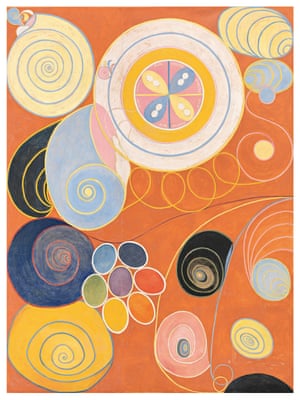
In MoMA’s magisterial, blockbuster show of 2012, Inventing Abstraction: 1910-1925, Af Klint was excluded. Reflex alarm at the occult seems to have been the explanation. What was harder to fathom was curator Leah Dickerman’s contention that Af Klint disqualifies herself by not having defined her paintings as art. Isn’t it amazing, I remark, how conservative art historians who specialise in the radical can be?Advertisement
“Hilma is a disturbing artist,” she responds excitedly. “We ask: what does it mean? Do we rewrite art history? Can we get away with saying she is an outsider? Can we put her in a box? Hilma was no layman, she was a trained and talented artist who knew about colour and composition.” She adds: “Creativity is bigger than art history. Hilma is like Leonardo – she wanted to understand who we are as human beings in the cosmos.” For Müller-Westermann, Af Klint is as important to Sweden as Münch to Norway.
Is it said that Hilma first become interested in the occult after the death of her 10-year-old sister Hermina. At 18, she helped her poor sister accept she was dying of flu. But Müller-Westermann sees this as too narrow a way in. Hilma was “mathematical, scientific, musical – curious”. Spiritualism, she reminds us, was more intellectually respectable then. Yeats, Mahler, Mondrian, Kandinsky – all were in its thrall. The Theosophical Society was founded in 1875 by Helena Petrovna Blavatsky and Anthroposophy by the philosopher Rudolf Steiner in 1912 – Hilma engaged with both. Müller-Westermann explains: “You have to understand this was the age when natural sciences went beyond the visible: Heinrich Hertz discovered electromagnetic waves [1886], Wilhelm Röntgen invented the x-ray [1895].” (With pleasing serendipity, the news about the proof of gravitational waves breaks while I am in Sweden – how Af Klint would have loved that.)
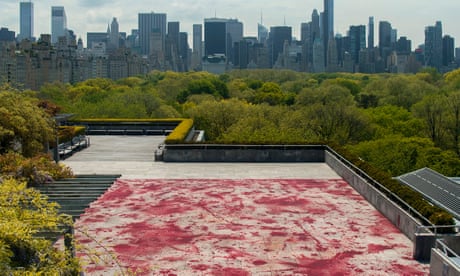
‘Violence is all around me’: Imran Qureshi on his disturbing miniatures
Read more
It is tempting to tell her story from a feminist point of view – but she was no feminist, and the truth is that she was better off as a female artist in Scandinavia (where they were permitted to work alongside men) than she would have been elsewhere in Europe. Having said that, Müller-Westermann is lightly contemptuous of her male counterparts: “Kandinsky was a super-smart lawyer who knew how to sell himself. It was all about ego. Men say: ‘Things come to me – I’m a genius.’ Hilma was more humble. For 10 years, she trained. She felt ready to trust in something she could not explain. She was about something bigger than ego. She had to ask: do I dare do this?”Advertisement
Fortunately, Af Klint was grounded. She was a conduit first, then an interpreter. She became a scholar of her own work, producing a beautiful and botanically precise symbolic lexicon. It cannot be easily telescoped, but these symbols dominate: spirals (evolution), U (the spiritual world), W (matter) and overlapping discs (unity). Yellow and roses (pleasingly) stood for masculinity. Blue and lilacs meant femininity. She may have been influenced by Goethe’s Theory of Colours (1810). Yellow was “next to the night”. Blue was “next to darkness”. Green was perfect harmony. She explored dualities – including male and female sexuality – but unity was always her goal (ironically for a female artist working alone).
A room in the Moderna Museet has been dedicated to Klint, and it is here we are to meet Johan. It is dominated by Swan (No 15), one of the Temple paintings exploring male and female energy (pink/spiritual love, red/physical love). It is striking, simple, peaceful. Looking at this piece is Johan: a trim man in his 70s with a smart overcoat, an explosive laugh and boundless energy. He has travelled the world as a financier and describes himself as having an affinity with his great aunt as a “seeker” – his passions are for Buddhism (and tennis).
Hilma was born into a Protestant, bourgeois naval family with no interest in art. She grew up in Karlberg castle, a naval academy. Her father, Captain Victor af Klint, was an admiral, mathematician and occasional violinist – with, as his portrait reveals, the same steady blue stare as his daughter, and flourishing sideburns. He died in 1898. It was to her nephew Eric, Johan’s father, that Hilma left her work. Johan describes his father as “very kind”. To Hilma, he must have seemed a safe pair of hands. But how did he feel about her bequest?
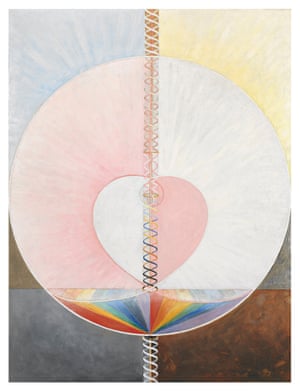
“He was horrified,” Johan laughs, as we get into the car to drive to Adelsö, the island 45 minutes west of Stockholm where Hilma spent her childhood summers. “He was an admiral of the fleet. He tried to understand Hilma’s interests – but shook his head.”
Hilma died without a krona, leaving only her work behind. Johan does not know how she survived. After her death, the farmer who owned the land on which her house and studio were built (she had left central Stockholm by this time) declared his intention to burn it down. Eric had the daunting task of emptying the studio at speed: “He built wooden crates and rolled everything up – 1,000 or more paintings were stored in our attic. We had a tin roof. Imagine! In summer it was sometimes 30 degrees, in winter, minus 15. Terrible. It is a miracle the paintings survived.”
But how lucky, I say, that Eric did his conscientious best by her. Artists need other people. Daniel Birnbaum, director of Moderna Museet and co-curator of the Serpentine exhibition, when I phone him later, observes: “Where would Picasso have been without his critics, his mistresses, his gallery owners?” He marvels that: “During her lifetime, Af Klint had no lobby, zero, nothing. Her art was like a thought experiment: if a tree falls in the forest and no one sees it, did it fall?”
It is a very Swedish image. We cross the water on the ferry to Adelsö where many a tree might fall unobserved. It is overcast, sleety: not a day to reconjure a luminous childhood, although the place has bleak presence. We drive past pine, silver birch and bedraggled snow to Hanmora, a family farm that has seen better days (bought in 1800, since sold) and to neighbouring Tofta where Hilma stayed. It is easy to picture the freedom she felt here. You could walk wherever you liked, “as long as you behaved”. There was no such thing as trespassing. Johan describes blueberrying, mushrooming, sailing, deer, elk and all the birds that he, too, enjoyed here as a child. “But light is the greatest influence. The ‘blue hour’ – dawn and dusk. And, in early summer, everything is clean. This is the wonder: the year dies and is reborn.”
Hilma’s passion for the natural world connects her traditional and abstract work. She knew its plants (she studied Linnaeus, the Swedish botanist) and animals (she worked as a draughtsman for a veterinary institute). Johan later shows me, in his sitting room, an exquisitely imprecise blue landscape glimpsed through the golden branches of a tree. You can already see in it a shift towards the abstract. As Birnbaum brilliantly explains: “Dig down into nature and into cellular structures and you find abstraction there. She was into geometric abstraction; her vision was to do with evolutionary theory, the biomorphic – she was very up-to-date.” And he lists contemporary artists who have found inspiration in Af Klint: Cecilia Edefalk in Sweden, Dominique Gonzalez-Foerster in Paris, RH Quaytman in New York, and Kerstin Brätsch and Adele Röder (whose work will be shown at the Serpentine with Hilma af Klint).
Does Johan really believe she had the gift of prophecy? ‘Oh yes,’ he says, ‘it is in our family’
But I am still in the dark about what she was like. Her personality? Johan hesitates – he was five when he met her. “She was very kind… reserved but not a recluse.” He probably does not remember more. Later, he emails me his father’s unpublished recollections. She had intensely blue eyes. She was tiny – about five feet – which makes her full-scale works all the more phenomenal. She painted on the ground (Johan detected, on one painting, a small footprint – Hilma was here). His father judged her unsentimental, no fantasist – high-minded. A word that reappears is “resolute”. She was a vegetarian. Like Chekhov’s Masha, she always wore black. “Life,” she declared, “is a farce if a person does not serve truth.” She sounds formidable – not cosy at all. But who knows? Did she have a sense of humour? “Oh yes,” says Johan.
She never married, although Johan says (tactfully, as if she might be listening in) that she had hoped to wed a man with an English name: Halliday. “That never materialised and she was sorry and there was a crisis.” He is hazy about the details. Later on, women seem to have answered her emotional needs. Johan mentions Gusten, one of her group, who died. Hilma poured her friend’s spirit into her painting.
Sometimes depression struck. In 1908, after making 111 paintings, she collapsed: “She had completed a painting every third day – including the 10 huge ones. She was exhausted.” And there was further reason for despond. That same year, Steiner was lecturing in Stockholm. She invited this charismatic man to see her paintings (Mondrian petitioned Steiner too, but always in vain). She had hoped he would interpret the work. Instead he advised: “No one must see this for 50 years.” For four years after this verdict she gave up painting and looked after her sightless mother. Johan shows me a photograph of Hilma at Hanmora, looking down with tenderness, a hand on her mother’s shoulder – the more sympathetic of clues to her character.
Back at Johan’s flat he shows me another photograph. It is a map, a “Sea atlas of Sweden and its islands” by Gustav af Klint (Hilma’s grandfather): intricate, beautiful, an astonishing labour based on the measurements he took around Viborg in the mid-1780s. I am dismissing this as irrelevant when it suddenly strikes me: Hilma was not as removed from her forebears as one might superficially suppose. She was a cartographer of the spirit. And she had an energy, zeal and perfectionism to equal her grandfather’s. She even thought in terms of maps. In an extraordinary, hair-raising watercolour, A Map of Great Britain (1932), she foresaw the second world war. A pale face blows fire towards Britain, darkness is about to engulf us. But does Johan really believe she had the gift of prophecy? “Oh yes,” he says, “it is in our family.”
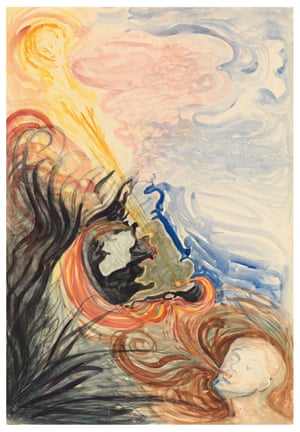
On the last morning in Stockholm I meet Patrick O’Neill, who married into the family, and runs the Hilma af Klint Foundation, set up in 1972 by Eric and until recently run by Johan. He says her work is now stored in a basement outside Stockholm, its market value tricky to assess. He explains that the foundation’s statutes require that Af Klint’s work be cared for, maintained and made accessible. But her abstracts have never been available on the international art market – it is one reason she has been off the radar. O’Neill believes this needs to change. His goal is simple: that she gets the attention she deserves.
He has no quarrel with the foundation’s stipulation that works such as the Temple cannot be sold – but Af Klint’s output was huge. His dream is to raise money to fund research into her work. Daniel Birnbaum’s slant on the future is different: he recommends the foundation donate selected works to museums internationally. “Why keep the paintings in a basement outside Stockholm? I’m not making a morally incorrect suggestion. Hilma was a secret painter with a group of women hiding in a studio in northern Europe. She was almost invisible.” And visibility, we agree, is all.
Just before leaving I meet Johan for a drive to the former navy graveyard Galärvarvskyrkogården, where Hilma is buried. He leads the way to a small stone set into the ground – modest compared with the flamboyant tombs surrounding it. It has started to snow and it is impossible to read the inscription. Johan brushes the snow away with a glove and reveals a name – Viktor af Klint. I am mystified, then I understand: she is buried with her father. Her name has gone. “We come and we vanish,” Johan says. But at least – as the Serpentine’s show will gloriously testify – she has not vanished without trace. Seventy years after her death, Hilma af Klint’s moment has come.
Hilma af Klint: Painting the Unseen is at the Serpentine Gallery, London W2, 3 March to 15 May
Source: https://www.theguardian.com/artanddesign/2016/feb/21/hilma-af-klint-occult-spiritualism-abstract-serpentine-gallery


